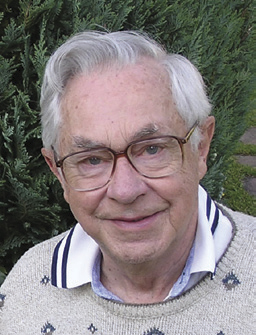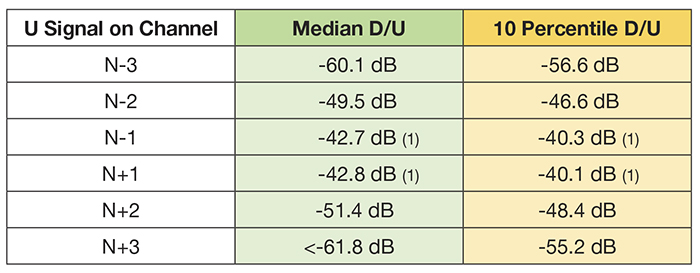Repacking Likely to Multiply Interference

Charles W. Rhodes
The FCC recently released details of how it will repack remaining TV spectrum in the UHF band. The law that authorized spectrum auctions requires the commission to protect reception of broadcast signals after the repacking, according to FCC/OET Bulletin No. 69, which gives protection ratios for co-channel interference (CCI) and for adjacent channel interference (ACI). These protection ratios are given as desired (D)/ undesired (U) ratios.
Bulletin No. 69 also says this about taboo channel DTV–DTV interference: “The evaluation of service and interference in Appendix B of the Sixth Report and Order considered taboo channel relationships for interference into DTV. However the D/U ratios (approximately –60 dB) were such that they rarely if ever had an effect on the results, and the FCC rules adopted in the Sixth Report and Order do not require attention to UHF taboo interference to DTV stations.” The Sixth Report and Order was dated April 1997.
So, the FCC must devise a repacking scheme that protects against CCI and ACI, but the commission may not protect against interference from DTV signals on other channels because in 1997, the FCC believed that such interference was not a real threat.
CO-CHANNEL INTERFERENCE BETWEEN ATSC SIGNALS

Fig. 1: Excerpts from the IEEE paper (Dec. 2010, Table VIII). Note: These D/U values were measured under laboratory conditions where the undesired (U) signal was not accompanied by sideband splatter. There was no U transmitter. The U signal was generated in a high quality ATSC Signal Generator. Receiver RF performance has nothing to do with CCI. DTV receivers see any uncorrelated signal weaker than the one they are decoding as noise. So any U signal is noise, and when it is in the same channel as the D signal, this is co-channel noise. CCI can only be avoided by physically separating transmitters operating on the same channel. Shortening the minimum distance between co-channel transmitters would increase CCI.
ADJACENT CHANNEL INTERFERENCE BETWEEN ATSC SIGNALS
As this column has been saying for months, ACI is due to the sideband splatter accompanying an U signal and which is within the channel to which the receiver is tuned. It is not due to either receiver overloading or poor IF selectivity (both are receiver issues).
The professional video industry's #1 source for news, trends and product and tech information. Sign up below.
This sideband splatter is third order inter- modulation products generated in the high power amplifier(s) of DTV transmitters and which pass through the transmitter RF mask filter and are radiated. The DTV RF mask limits the sideband splatter in each adjacent channel to –44.7 dB below the power radiated with the transmitter’s assigned channel. The IF selectivity of ATSC receivers provides about 1.8 dB of additional attenuation of sideband splatter so the effective noise level in the D channel of the receiver is –46.5 dB (if not more), below the U signal power received on an adjacent channel. We have observed that the sideband splatter radiated by local stations is about 49.5 dB below their ATSC signal power, a 3 dB margin with respect to the FCC limit. This may give them improved coverage where there is an ACI problem.

Fig. 2: Excerpts from the IEEE Paper (Dec. 2010, Table X). Note: While the N+10, N+20 and N-10, N-20 data probably would not apply to the repacked UHF spectrum, and certainly does not apply to the VHF spectrum, four additional channel pairs that could cause interference were not tested and reported in the IEEE paper. These channel pairs are: N-8 & N-4 and N+4 & N+8 and N-2 & N-1, and N+1 & N+2. Assume that the received U power is –43 dBm, the noise in the D channel is –89.5 dBm, plus the receiver-generated noise (about –99 dBm); so the total noise under the D signal power is about –89 dBm. The minimum signal-to-noise ratio for our ATSC signal is 15.2 dB, so the minimum usable signal power is –73.8 dBm.
The D/U ratio is –27.8 dB, which is nearly the FCC limit (–28 dB) for a U signal below the D signal. An ideal receiver would require at least –73.8 dBm of D signal power to work in this worst case D/U situation. The ideal receiver is desensitized by about 10 dB due to worst case ACI from one transmitter.
This demonstrates that ACI is due to the finite linearity of DTV transmitters. So ACI is controlled by the distance between the two transmitters. Here we have a paradox— suppose they are co-sited? The D/U ratio would be close to zero dB and there would be no ACI. Suppose the transmitters on adjacent channels are 100 miles apart? The U signal and its sideband splatter would be too weak to cause ACI at the noise limited perimeter of the D station. There are two ways to win: Co-site and far site such transmitters.
TABOO CHANNEL INTERFERENCE BETWEEN ATSC SIGNALS
Fast forward to December 2010, when a paper reporting on the DTV-DTV interference susceptibility of converter boxes was published in “IEEE Transactions on Broadcasting,” which reported the FCC’s Laboratory tests of converter boxes at the request of the NTIA. The NTIA distributed 33 million coupons requested by the public for digital converter boxes, so there is a significant audience using converter boxes.
Fig. 1 shows data from Table VIII from the 2010 IEEE paper. Table VIII gives data for a single U ATSC signal, which in this case is for a D signal power of –68 dBm. At the median D/U, 50 percent of units tested failed; at 10th percentile, only 10 percent failed.
Broadcasters might want to consider whether losing 50 percent of their audience near the perimeter of their ACI limited coverage is acceptable or should such losses be minimized by insisting on 10 percent loss at the ACI limited perimeter be the maximum.
INTERFERENCE GENERATED IN THE RECEIVER
Two U signals on certain pairs of channels (of the form N+K, N+2K where K is an integer which may be either +/-), can overload a receiver generating second and/ or third order distortion products.
Data for single conversion tuners (where IF = 44 MHz), and double conversion tuners (where first IF = 1222 MHz), are presented separately in Table X, of the 2010 IEEE publication for reasons that will be immediately obvious upon inspection of this table (see Fig. 2).
The IEEE paper referred to above reported finding interference suffered by the 19 double conversion tuner-equipped converters when an ATSC U signal was on channel N+9 and the D channel (N) was on channel 28. In the May 2013 issue of “IEEE Transactions on Consumer Electronics,” I, along with my colleagues Linley Gumm and Stanley Knight, went further, showing that ATSC signals on any channel pair of the form channel 37 – X and channel 37 + X produces a second order distortion product centered at 1222 MHz. This is the first IF of all double conversion tuner equipped converter boxes we tested. We noted on p. 306, that “if any of these pairs of signals appear with sufficient amplitude at the input of a double conversion receiver, that receiver may experience de-sensitization regardless of the channel to which it is tuned.”
It should be noted that in 2004, there was little awareness in the industry of the effects of either second or third order nonlinear distortion of a digital signal upon the reception of another digital signal. The first paper on this topic by Gary Sgrignoli and myself was published in the May 2005 issue of “IEEE Transactions on Consumer Electronics.”
It should also be noted that from Table X of the IEEE 2010 Paper (Fig. 2), that both single conversion and double conversion tuner-equipped converter boxes tested were susceptible to interference from U signals on certain pairs of channels much more than the interference from either U signal alone.
CONCLUSION
The data published in the December 2010 issue of “IEEE Transactions on Broadcasting” is from the FCC Laboratory. A significant portion of the ATSC converter boxes for which the NTIA distributed coupons proved to be especially susceptible to interference from two U ATSC signals on channels of the form N+K, N+2K (K is an integer either +/-). There are two victim channels: N and N+3K.
When the FCC repacks the remaining UHF TV spectrum, there will be significantly more cases where two channels are of the above form in which case, more interference may result. There are also additional third order distortion products generated in overloaded tuners when the number of U signals is greater than two.
As things now stand, the FCC has no alternative but to follow the law and protect only against CCI and ACI from a single source.
If there is widespread interference, many of the ATSC converter boxes and some DTV receivers might have to be replaced for a substantial number of people to be able to continue receiving OTA signals.
Charlie Rhodes is a consultant in the field of television broadcast technologies and planning. He can be reached via email atcwr@bootit.com.
